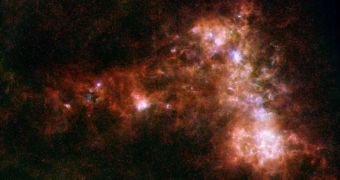The latest observations from the European Space Agency's Herschel Space Observatory reveal dust concentrations in the Large and Small Magellanic Clouds (LMC/SMC), two dwarf galaxies orbiting the Milky Way at close range.
Knowing how cosmic dust and gas are distributed throughout a galaxy is essential towards determining whether that particular cosmic formation will create new stars. The data can also be used to model how the structure would react upon merging with another galaxy.
Herschel is currently the most advanced telescope ever deployed in space. The near-infrared data it collected of the SMC and LMC were augmented with additional readings from the NASA Spitzer Space Telescope (SSC).
According to a NASA press release, “the colors in these images indicate temperatures in the dust that permeate the Magellanic Clouds. Colder regions show where star formation is at its earliest stages or is shut off, while warm expanses point to new stars heating dust surrounding them.”
The Spectral and Photometric Imaging Receiver instrument on Herschel captured the reddest wavelengths in this photo, at 250 microns. The Photodetector Array Camera and Spectrometer (PACS) collected data at 100 and 160 microns, shown here in green.
The blue colors in this image are generated by 24- and 70-micron data from the SSC, and represent the warmest spots in the two dwarf galaxies. “Studying these galaxies offers us the best opportunity to study star formation outside of the Milky Way,” expert Margaret Meixner says.
“Star formation affects the evolution of galaxies, so we hope understanding the story of these stars will answer questions about galactic life cycles,” adds the astronomer, who is based at the Space Telescope Science Institute (STScI), in Baltimore, Maryland.
Details of the research effort were presented yesterday, January 10, at the 219th meeting of the American Astronomical Society (AAS2012), in Austin, Texas. Meixner was the principal investigator on the mapping project.
In the future, astronomers plan to include the new data inside more complex models seeking to decipher galaxies' rich evolutionary history. Emphasis will be placed on how these structures looked like billions of years ago, when stellar formation was at its peak.

 14 DAY TRIAL //
14 DAY TRIAL //